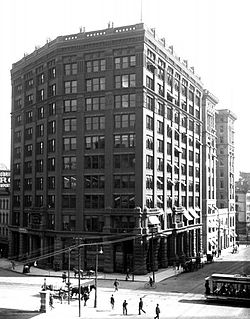Hammond Building
| Hammond Building | |
|---|---|

c.1900
|
|
| General information | |
| Status | Demolished |
| Type | Commercial offices |
| Location | 632-656 Griswold Street Detroit, Michigan |
| Coordinates | 42°19′50″N 83°02′50″W / 42.3306°N 83.0471°WCoordinates: 42°19′50″N 83°02′50″W / 42.3306°N 83.0471°W |
| Completed | 1889 |
| Demolished | 1956 |
| Height | |
| Roof | 45.72 m (150.0 ft) |
| Technical details | |
| Floor count | 10 plus excavated basement |
| Design and construction | |
| Architect | George H. Edbrooke |
| References | |
The Hammond Building was a high-rise building completed in 1889 at the southeast corner of Griswold Street and West Fort Street in the financial district of downtown Detroit, Michigan directly across Fort Street from the Detroit City Hall. The 46 m (151 ft) building was designed by George H. Edbrooke, and is considered the first historic steel-framed skyscraper in the city, and was the tallest in the state when built. Russell Wheel & Foundry supplied and erected the iron and structural steel for the building. The Hammond Building was demolished in 1956 to make way for the National Bank of Detroit Building, which has since been renamed The Qube. At 12 stories, the steel-framed United Way Community Services Building (1895), originally the Chamber of Commerce Building, qualifies as Detroit's oldest existing skyscraper.
Born in Massachusetts, George H. Hammond moved to Detroit in 1854 and opened a small meat market at the corner of Third and Howard streets. Hammond later bought a refrigerated boxcar patent from William Davis, a Detroit fish dealer. Davis' idea involved using horsehair to line the car. Next to the shell were sheet metal tanks for broken ice and salt. Hammond used Davis' boxcar to successfully move beef to market; the first trial run occurring in May 1869, moving beef from Detroit to Boston, MA using ice from the Detroit River
Hammond eventually established operations in Hammond, Indiana to manufacture the refrigerated cars. His operations, which were located near the stockyards in Chicago, included slaughtering and meat processing operations. He amassed a business that owned over 800 refrigerator cars and slaughtered 100,000 head of cattle annually. As the meat was processed, it was loaded into the refrigerated rail cars and shipped cross country to the east coast. Hammond died in 1886 leaving his fortune to his wife, Ellen Hammond. Ellen divested her interests in the meat packing business in 1888, receiving over $2 million at the time. Hammond had started making plans for his skyscraper in the early 1880s. After his death, Ellen purchased the property for $350,000 and commissioned the building which was completed in 1889.
...
Wikipedia
